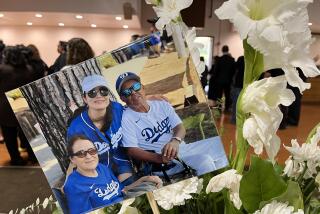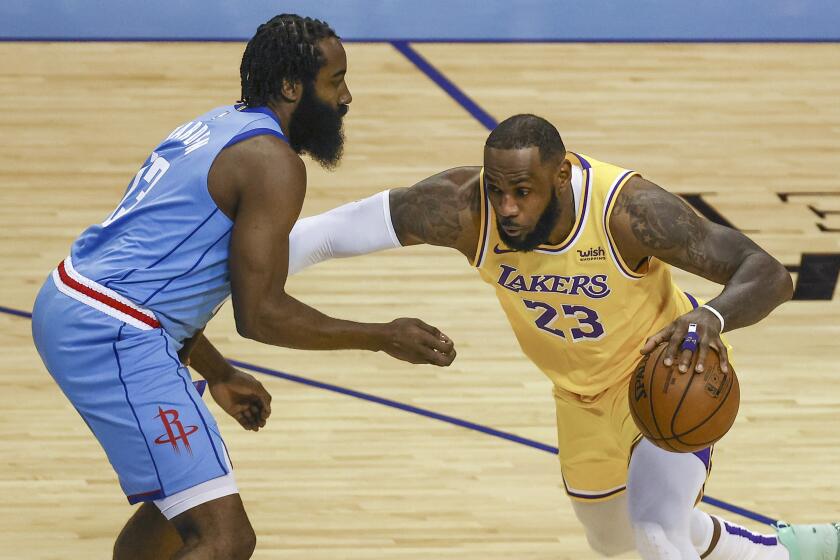WICKED STICKS : As Metalurgy and Technology Advance, Baseballs are Rocketing Off Bats at Ever-Increasing Speeds, but Nobody Has Moved the Mound Back Yet
- Share via
Danny Crawford recalls throwing a fastball over the outside corner of the plate and hearing the “ping” of an aluminum bat.
A pitcher needs only 0.4 seconds to raise his glove in self-defense, researchers estimate. But Crawford, playing for the University of Houston, was facing a Texas A&M; batter who hit a line drive back to the mound in 0.29 seconds.
“I didn’t even see the ball,” Crawford said. “I heard it come off the bat and, a split-second later, I heard the crack of my mouth.”
Five of his teeth shattered--one flew almost to the shortstop--and a doctor needed 62 stitches to mend his face on that afternoon last spring.
Though such injuries are rare in college baseball, several recent incidents, including at least three this season, have raised new concerns. Each year at the College World Series, which begins today in Omaha, manufacturers unveil lighter, more potent bats. Some coaches and players worry that these high-tech marvels have outgrown the age-old dimensions of the diamond.
“Holy cow, we’re going to get a kid killed,” said Bill Thurston, coach at Amherst and secretary of the NCAA’s baseball rules committee. “The bats are just too good.”
The NCAA has funded a study, due in July, to determine if bats should be deadened or otherwise changed. It is a prickly issue, debated within the game and opposed by the sporting goods industry, which has millions of dollars at stake.
At Easton Sports, a Van Nuys factory that produces 1.8 million bats a year, an executive wonders why the NCAA isn’t investigating ball manufacturers or the lack of good college pitching.
“We’re a scapegoat,” said Jim Darby, vice president of promotions. “We are the different animal on a traditional field.”
*
The debate has persisted since the mid-1970s, when aluminum became commonplace in the college game.
Pitchers dread that “ping.” “My biggest nightmare--110 miles an hour coming at me,” USC pitcher Randy Flores said.
Hitters embrace the added punch. “It’s the college game,” said Jose Miranda, who hit 25 home runs for Cal State Northridge this season. “It’s our identity.”
Darby calls it “a problem of perception versus reality. The purists think aluminum makes a horrible sound, that the ball rockets off the bat.”
Early models were actually clunky, barely more powerful than wood. They were economical, however, allowing players to go all season without having to replace a broken bat. While professional baseball sneered, aluminum became a fixture at amateur levels. And as time passed, manufacturers such as Easton, Worth and Hillerich & Bradsby escalated the baseball bat war.
A new alloy hit the market every few years, engineers stretching the metal progressively thinner. Bats weighed less and were swung faster with more punch. A well-struck ball flew as fast as 120 mph, an estimated 15 mph faster than off wood. Elongated sweet spots produced more clean hits.
“You can get away with a lot of bad mechanics,” said Eric Karros, a star at UCLA before joining the Dodgers. “An aluminum bat can make a bad hitter into a good hitter.”
More offense was generally considered good for the game.
“The exciting part is when you score,” said Miami Coach Jim Morris, a rules committee member. “That’s when people are jumping up and down and hollering.”
But some saw a dangerous side-effect. Pepperdine pitcher Tony Lewis was felled by a line drive in a 1987 game against USC. And the offensive outburst bothered coaches such as Dave Snow at Long Beach State, who noticed games with 20 and 30 runs being scored.
The scoring issue came to a head at the 1995 College World Series when manufacturers introduced yet another alloy, an aerospace invention called “C405.” The new bats, helped by a prevailing wind to right field, produced 48 home runs in 14 games, obliterating the old mark of 29.
NCAA officials summoned manufacturers to a meeting in Lake Tahoe.
“They said, ‘We’re very irritated with you,’ ” Darby recalled. “So we manufacturers suggested that if they didn’t like what happened in 1995, we’d go back to the 1994 bats.”
Manufacturers also proposed a scientific standard by which bats could be measured.
There was scant research. At New York University, Richard Brandt fired pitches at a stationary bat. At the University of Arizona, Terry Bahill used computer animations. Steve Baum, who manufactures synthetic bats, was developing a pitching-hitting machine calibrated to the eighth decimal place.
Baum surmised that heavier bats would be harder to swing, producing fewer clean hits. Bahill argued that with heavier bats, those fewer clean hits would be even more lethal.
Manufacturers endorsed Brandt, who devised a “bat performance factor” or BPF. His tests showed that the 1995 bats hit the ball roughly 19% harder than wood. The 1994 bats hit only 14% harder.
The NCAA adopted the 1994 BPF, with a 1% margin of error, and manufacturers tamed their technology. At the College World Series last year, the home run total dipped to 34.
“Everyone should have been happy,” Brandt said.
Not everyone was.
Some coaches still believe that the game has strayed too far from its roots.
“They’re coming up with these alloys that are so light and powerful . . . a 34-inch bat weighing 29 ounces is ridiculous,” UCLA Coach Gary Adams said. “We’ve reached the maximum of absurdity.”
Others, such as Arkansas Coach Norm DeBriyn, continue to fret about the safety of their players.
Pitchers have always faced harrowing comebackers, even from wood bats (witness Detroit Tiger Willie Blair’s broken jaw in a recent game at Cleveland). And comebackers account for only 3% of the injuries in what ranks among the safest of men’s and women’s collegiate sports.
But some coaches are worried.
“If a coach sits in the dugout or stands at third base every day during the season, he observes that the ball is being hit much harder, thus creating a more dangerous environment for the players,” said Dave Keilitz, executive director of the American Baseball Coaches Assn.
Earlier this season, Scott Oliver of the College of Charleston was hit by a line drive and needed surgery for a broken cheekbone. At Northwestern State in Natchitoches, La., two pitchers have been hit this year, one of them suffering a broken jaw.
“When this type of injury does happen, it has the potential of being very serious,” said Randall Dick, the NCAA’s assistant director of sports sciences. “Do you wait for a fatal injury . . . or do you act based on judgment?”
The NCAA rules committee is strongly considering a rule change that would reduce the length-to-weight differential from 5 to 2.5 by 1999. In other words, the 34-inch bat that UCLA’s Adams complained about could weigh no less than 31.5 ounces.
Manufacturers argue that the change would render millions of bats obsolete. More important, with each new limitation on performance, leading companies lose their technological edge over smaller competitors.
“Not to say that people don’t get hurt,” said Sebastian DiCasoli, a Sporting Goods Manufacturers Assn. executive. “But there doesn’t seem to be a real problem, not according to the NCAA’s own data.”
Or, as the board chairman of one manufacturer said, “The NCAA is using scare tactics. I expect someone to step forward and blame jock itch on the aluminum bat.”
*
Karros whistles and shakes his head at the thought of using aluminum in the major leagues.
“Never, ever happen,” he said. “You would have deaths out on the field.”
New York Met pitcher Bobby Jones, who played at Fresno State, agreed. “They’d have to move everything 50 feet back, even the mound.”
But neither player recalls being anti-aluminum in college. And even critics such as Thurston are not suggesting that the bats be outlawed.
Most university athletic departments couldn’t afford to switch, nor could college players get quality bats because good wood is scarce. So the question becomes: Does the NCAA want aluminum bats to feel and perform more like wood?
The rules committee will face such a decision when it receives the findings from its study July 8.
This time around, Brandt has washed his hands of the matter. The physics professor said that too many coaches--including some on the rules committee--have arrangements by which their teams receive free bats from manufacturers. He said: “It has become too political.”
So the NCAA has turned to Trey Crisco, a Brown University professor and director of Rhode Island Hospital’s bioengineering laboratory. Crisco is using several methods to test bats and balls, hoping to find common ground between Brandt, Bahill and others.
His study must also account for the men who play the game. How do changes in bat weight influence hitting? Does a pitcher’s motion effect his reaction time? Where should the balance be struck between safety and competition?
“You can measure the difference between a wood bat and an aluminum bat, but what does that mean on the field?” Crisco asked.
As Bahill put it, “No one has bothered to figure out what the problem is.”
In Houston, there is a young man who believes he knows what the problem is. Danny Crawford recovered quickly enough to finish the 1996 season. He no longer plays baseball but retains a souvenir of the game--upper and lower bridgework.
“The bats are so live and, with the weightlifting programs that all the big schools have, the guys are getting bigger and stronger,” Crawford said. “Coming from a pitcher, I can say that they need to put restrictions on those bats.”
(BEGIN TEXT OF INFOBOX / INFOGRAPHIC)
The Bat Story
Anthony Merola was making aluminum pool cues in Pittsburgh during the late 1960s when inspiration struck.
His cues were shaped something like baseball bats, so the entrepreneur got his hands on bigger tubes and shifted his technology to the diamond.
He never got far with the notion, but a handful of major manufacturers took notice. Merola’s brainstorm set off a multimillion-dollar industry and a race for technological advancements:
* 1970: Wilson Sporting Goods markets a 38-ounce behemoth called the Indestructo. Worth comes out with a more svelte design and sells 10,000 bats for $10 each.
Early models are used for practice. Little League approves aluminum for games in 1971. The NCAA follows suit in 1974.
* 1978: Manufacturers introduce CU31, a technological breakthrough in terms of high-tech alloys. According to Hillerich & Bradsby, maker of the Louisville Slugger wood bats, CU31 is 31% stronger than previous metal materials.
* 1987: Easton comes out with EA70, a higher-grade aluminum.
* 1993: Hillerich & Bradsby develops a bat with a full-length, 2 3/4-inch barrel, adding 10% more hitting area.
* 1995: An aerospace alloy called C405 reaches the market. At the College World Series, teams hit 48 home runs in 14 games, smashing the old record of 29. The NCAA calls for performance limits.
* 1997: Easton has introduced Scandium, an alloy that can be found only in Russia. Hillerich & Bradsby is filling its new bats with pressurized air. Worth’s “cryogenic” model is manufactured at temperatures approaching minus-310 degrees Fahrenheit.
The NCAA will consider further restrictions at a July 8 meeting.
More to Read
Go beyond the scoreboard
Get the latest on L.A.'s teams in the daily Sports Report newsletter.
You may occasionally receive promotional content from the Los Angeles Times.











